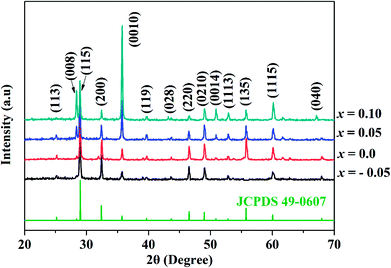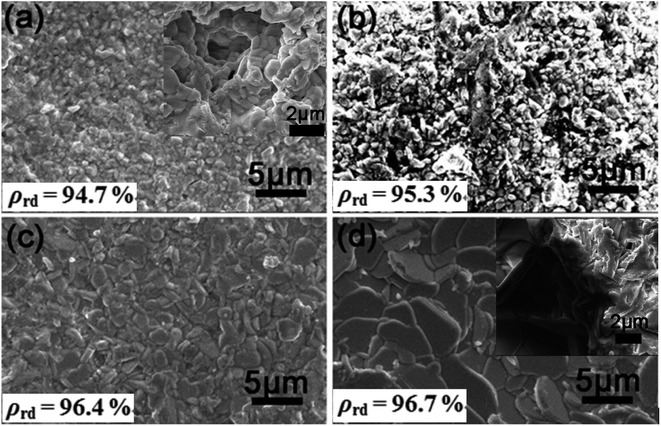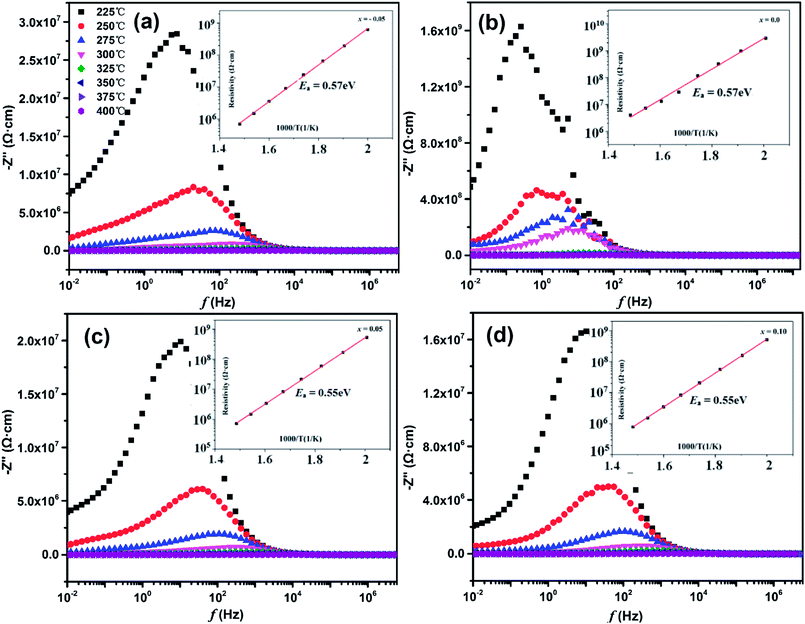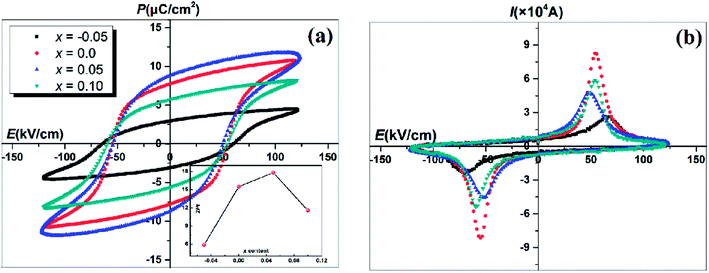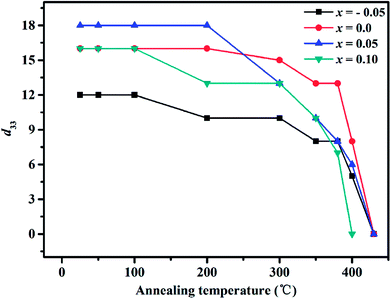 Open Access Article
Open Access ArticleCreative Commons Attribution 3.0 Unported Licence
Effect of Bi2O3 content on the microstructure and electrical properties of SrBi2Nb2O9 piezoelectric ceramics
Xiaochun Hea,
Ruiqing Chu *a,
Zhijun Xua,
Zhongran Yaob and
Jigong Haob
*a,
Zhijun Xua,
Zhongran Yaob and
Jigong Haob
aSchool of Environmental and Materials Engineering, Yantai University, Yantai, 264005, Shandong, China. E-mail: ruiqingchu@sohu.com
bCollege of Materials Science and Engineering, Liaocheng University, Liaocheng 252059, Shandong, China
First published on 25th April 2018
Abstract
Lead-free ceramics, SrBi2Nb2O9–xBi2O3 (SBN–xBi), with different Bi contents of which the molar ratio, n(Sr)![[thin space (1/6-em)]](https://www.rsc.org/images/entities/char_2009.gif) :
:![[thin space (1/6-em)]](https://www.rsc.org/images/entities/char_2009.gif) n(Bi)
n(Bi)![[thin space (1/6-em)]](https://www.rsc.org/images/entities/char_2009.gif) :
:![[thin space (1/6-em)]](https://www.rsc.org/images/entities/char_2009.gif) n(Nb), is 1
n(Nb), is 1![[thin space (1/6-em)]](https://www.rsc.org/images/entities/char_2009.gif) :
:![[thin space (1/6-em)]](https://www.rsc.org/images/entities/char_2009.gif) 2(1 + x/2)
2(1 + x/2)![[thin space (1/6-em)]](https://www.rsc.org/images/entities/char_2009.gif) :
:![[thin space (1/6-em)]](https://www.rsc.org/images/entities/char_2009.gif) 2 (x = −0.05, 0.0, 0.05, 0.10), were prepared by conventional solid-state reaction method. The effect of excess bismuth on the crystal structure, microstructure and electrical properties of the ceramics were investigated. A layered perovskite structure without any detectable secondary phase and plate-like morphologies of the grains were clearly observed in all samples. The value of the activation energy suggested that the defects in samples could be related to oxygen vacancies. Excellent electrical properties (e.g., d33 = 18 pC N−1, 2Pr = 17.8 μC cm−2, ρrd = 96.4% and Tc = 420 °C) were simultaneously obtained in the ceramic where x = 0.05. Thermal annealing studies indicated the SBN–xBi ceramics system possessed stable piezoelectric properties, demonstrating that the samples could be promising candidates for high-temperature applications.
2 (x = −0.05, 0.0, 0.05, 0.10), were prepared by conventional solid-state reaction method. The effect of excess bismuth on the crystal structure, microstructure and electrical properties of the ceramics were investigated. A layered perovskite structure without any detectable secondary phase and plate-like morphologies of the grains were clearly observed in all samples. The value of the activation energy suggested that the defects in samples could be related to oxygen vacancies. Excellent electrical properties (e.g., d33 = 18 pC N−1, 2Pr = 17.8 μC cm−2, ρrd = 96.4% and Tc = 420 °C) were simultaneously obtained in the ceramic where x = 0.05. Thermal annealing studies indicated the SBN–xBi ceramics system possessed stable piezoelectric properties, demonstrating that the samples could be promising candidates for high-temperature applications.
1. Introduction
Lead-based ceramics, such as Pb(Zr,Ti)O3, have been widely used in applications of the economic industry field, including piezoelectric transformers, sensors and actuators, because of their excellent piezoelectric and ferroelectric properties.1,2 However, with the ever-increasing demands relating to environmental concerns, the lead-based ferroelectric and piezoelectric materials are facing several challenges for actual electronic applications due to the high toxicity of lead oxide.3 Therefore, it is necessary to develop lead-free compounds for the replacement of lead-based ceramics.Bismuth layer-structured ferroelectric ceramics (BLSFs), known as the Aurivillius family of oxides, have been considered as one kind of promising lead-free piezoelectrics in high-temperature applications because of their high Curie temperatures, low dielectric loss and low aging rates.4–6 The structure of these ferroelectrics consists of [Bi2O2]2+ layers interleaved with a perovskite block of [Am−1BmO3m+1]2− units stacked along the crystallographic c-axes, where m represents the number of perovskite blocks and the m value is generally in the range of 1–5. Additionally, the number of [BO6] octahedrals included in the pseudo-perovskite structure is reported to have a close relationship with dielectric and ferroelectric properties.7,8 SrBi2Nb2O9 (abbreviated as SBN), as the m = 2 member of the Aurivillius family with Sr and Bi ions at the A sites and Nb ions at the B sites, consists of (Bi2O2)2+ layers and pseudo-perovskite ((SrNb2O7)2−) units with double NbO6 octahedral layers.9 Among BLSFs, SBN has been extensively studied due to its relatively lower crystallization temperature and it is a promising material for high-temperature piezoelectric applications such as piezoelectric accelerometer, especially in the vibration monitoring system at nuclear power plants, owing to its high Curie temperature of 450 °C and high electrical resistance of 106 Ω cm at 375 °C.10 However, as other BLSFs compounds, the remanent polarization and piezoelectric activities of SBN ceramics are relatively low due to two-dimensional orientation restriction in rotation of spontaneous polarization, which limits its applicability in piezoelectric devices requiring high temperatures.11
Many studies have focused on enhancing the electrical properties of BLSFs, such as change of the grain size,12 control of preferred orientation,13 and A and/or B-site substitution.7,8,10 In addition, it is well known that highly volatile nature of Bi ions at high-temperature heat treatment will cause a non-stoichiometric composition along with the defects of (VBi3+)′′′ and (VO2+)′′, which could weaken the electrical properties of ceramic because of the large ferroelectricity and better electromechanical properties of the ceramics are attributed to Bi3+ ions.14,15 Thus, many practices have been performed to qualitatively add excess amounts of raw Bi2O3 powders to compensate for the potential loss and then affect the electrical properties as reported in Bi-containing functional ceramics and films.14,16,17 For instance, Qin et al.18 reported a CaBi2Nb2O9 + 1 wt% Bi2O3 ceramic with optimal electrical properties as follows: piezoelectric constant d33 = 6.4 pC N−1, resistivity ρ = 2.9 × 106 Ω cm (@500 °C) and Curie temperature Tc = 940 °C. However, there have been few reports regarding the effect of excess Bi on the structure and electrical properties of SBN ceramics, in spite of the possibility of compositional variation induced by volatilization of bismuth element. In this study, SBN ceramic was selected as a host material and the structural defects of the SBN ceramic were compensated by regulating the Bi2O3 concentration, to modify the poling process and the electrical properties of ceramics. The optimal Bi2O3 concentration was investigated and the structure–property relationships and possible mechanism were additional discussed.
2. Experimental procedure
Polycrystalline SrBi2Nb2O9–xBi2O3 (SBN–xBi, x = −0.05, 0.0, 0.05, 0.10) ceramics were prepared via solid-state reaction method using SrCO3 (99%), Nb2O5 (99.5%) and Bi2O3 (99.99%). All raw materials were ball milling in a polyethylene with stabilized zirconia balls for 15 h. The mixed powders dried and initially pre-calcined at 800 °C for 2 h. Then, the mixture was milled again for 12 h. The slurries were dried and pressed into pallets of thickness 0.5 mm and 12 mm in diameter. The pallets were sintered at 1100 °C for 3 h. For the electric measurements, disk samples with about 0.3 mm in thickness were used.The density of the sintered ceramics was measured by means of the Archimedes method. The phase constituent of the sintered samples was determined by X-ray diffraction (XRD) using a Cu Kα radiation (λ = 1.54178 Å) (D8 Advance, Bruker Inc., Germany). The surface morphology of the ceramics was observed by scanning electron microscope (SEM) (JSM-6380, Japan). The ferroelectric hysteresis loops were measured through standardized ferroelectric test system (TF2000, Germany). The temperature dependence of dielectric properties and impedance spectroscopy for the samples was performed using a Broadband Dielectric Spectrometer (Novocontrol Germany). The samples were polarized in silicon oil in the range of 150–180 °C for 20 min, and piezoelectric measurements were carried out with a quasi-static d33-meterYE2730 (SINOCERA, China).
3. Results and discussions
The X-ray diffraction spectra of SBN–xBi ceramics in the 2θ range of 20–70°are shown in Fig. 1. It is obvious that all the prominent peaks show the samples possess a single bismuth-layered perovskite structure without any detectable secondary phases, indicating that Bi2O3 has diffused into SrBi2Nb2O9 lattices to form a new solid solution SBN–xBi. In addition, when the doping content is lower, the highest diffraction peak of SBN–xBi ceramics is (115) orientation, which is in good agreement with the highest diffraction peaks of (112m + 1) in BLSFs phase and belongs to orthorhombic structure (JCPDS 49-0607).10 However, with the increase of the doping content, the (0010) peak enhanced gradually, and the peak value is much higher than that of (115) peak when the Bi2O3 content is 0.10, which could be ascribed to that the excess Bi2O3 can act as a sintering additive affecting the crystal growth and then affecting the crystal orientation of SBN–xBi ceramics. Thus, the variation of crystal orientation could affect the microstructure of SBN–xBi ceramics.Fig. 2 depicted the SEM micrographs for the nature surface of SBN–xBi ceramics sintered at 1100 °C. It could be clearly found that the grains of all the samples are well-defined and the distinct pores decrease with increasing Bi2O3 content, indicating the excess Bi3+ could effectively promote sintering of the SBN ceramics and suppress the occurrence of defects. In addition, the grain size increases gradually with the increasing Bi2O3 content, suggesting that the excess Bi2O3 could acts as a grain growth accelerant and has an evident effect on grain size of SBN ceramics. In order to determine the increased grain size, we polished and etched the surface of the samples, as shown in inset of Fig. 2(a) and (d). It is clear that the grain size of SBN–0.1Bi is much larger than that of SBN–(−0.05)Bi, indicating the grain size of ceramics could be increased gradually with the increasing Bi2O3 content. Such a behavior was also observed in CaBi2Nb2O9 + x wt% Bi2O3 (ref. 18) and BaBi4Ti4O15 + x wt% Bi2O3.19 As shown in Fig. 2, all ceramics have a high relative density ρrd (>94%, Table 1) and the ρrd value of the samples increases slightly with increasing Bi2O3 content, which could be related to the sintering additive promoting of excess Bi2O3 and the increased grain size: with increasing grain growth, the number of pores was found to decrease, which is beneficial for promoting electrical properties. Moreover, the strongly anisotropic and plate-like morphologies of SBN–xBi samples can be obtained as the Bi2O3 content up to 0.05 and 0.1, which was typical structure of the ceramic materials based on Aurivillius compounds.9
![[thin space (1/6-em)]](https://www.rsc.org/images/entities/char_2009.gif) δ) obtained at 1 MHz
δ) obtained at 1 MHz
| Samples (x) | εRT | tan![[thin space (1/6-em)]](https://www.rsc.org/images/entities/char_2009.gif) δ (%) δ (%) |
Tc (°C) | Ea (eV) | 2Pr (μC cm−2) | Ec (kV cm−1) | d33 (pC N−1) | ρrd (%) |
|---|---|---|---|---|---|---|---|---|
| −0.05 | 171 | 0.5 | 433 | 0.57 | 5.9 | 66 | 12 | 94.7 |
| 0.0 | 160 | 1.7 | 445 | 0.57 | 15.5 | 55 | 16 | 95.3 |
| 0.05 | 152 | 0.5 | 420 | 0.55 | 17.8 | 50 | 18 | 96.4 |
| 0.10 | 143 | 0.6 | 422 | 0.55 | 11.5 | 54 | 16 | 96.7 |
Fig. 3 shows the temperature dependence of dielectric constant (ε) and dielectric loss (tan![[thin space (1/6-em)]](https://www.rsc.org/images/entities/char_2009.gif) δ) of SBN–xBi ceramics at 1 MHz. The principal properties of the SrBi2Nb2O9 + xBi2O3 ceramics are listed in Table 1. As shown in Fig. 3 and Table 1, only one sharp dielectric peaks, corresponds to the Curie temperature (Tc), appeared when the temperature is higher than 400 °C for all the SBN–xBi ceramics. It is also clear that the dielectric loss values were low and stable when the measurement temperature is below 400 °C, which is of great importance for high-temperature device applications. Interestingly, the dielectric constant and loss of x = 0.0 is much larger than other samples, which could be closely related to its small grains as shown in Fig. 2b. Actually, in the BLSF Aurivillius structure, the spontaneous polarization takes place mainly in the a–b plane and the contribution along the c axis is less significant.18,20 Therefore, for BLSF polycrystalline ceramics, the grain size strongly affects the electrical properties as reported by Chen et al.21 In addition, the tan
δ) of SBN–xBi ceramics at 1 MHz. The principal properties of the SrBi2Nb2O9 + xBi2O3 ceramics are listed in Table 1. As shown in Fig. 3 and Table 1, only one sharp dielectric peaks, corresponds to the Curie temperature (Tc), appeared when the temperature is higher than 400 °C for all the SBN–xBi ceramics. It is also clear that the dielectric loss values were low and stable when the measurement temperature is below 400 °C, which is of great importance for high-temperature device applications. Interestingly, the dielectric constant and loss of x = 0.0 is much larger than other samples, which could be closely related to its small grains as shown in Fig. 2b. Actually, in the BLSF Aurivillius structure, the spontaneous polarization takes place mainly in the a–b plane and the contribution along the c axis is less significant.18,20 Therefore, for BLSF polycrystalline ceramics, the grain size strongly affects the electrical properties as reported by Chen et al.21 In addition, the tan![[thin space (1/6-em)]](https://www.rsc.org/images/entities/char_2009.gif) δ value significantly increased when the temperature was above 450 °C, which could be related to the space charge carriers induced by the increase of electrical conductivity at high temperatures.22
δ value significantly increased when the temperature was above 450 °C, which could be related to the space charge carriers induced by the increase of electrical conductivity at high temperatures.22
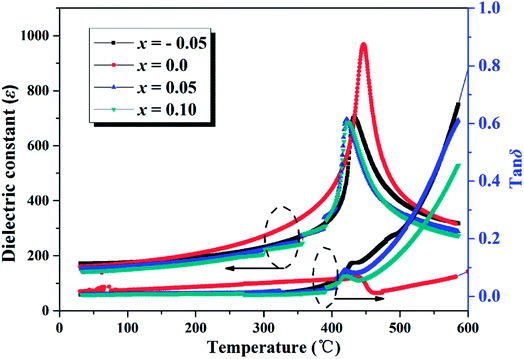 | ||
Fig. 3 Temperature dependence of dielectric constant (ε) and loss (tan![[thin space (1/6-em)]](https://www.rsc.org/images/entities/char_2009.gif) δ) of SBN–xBi ceramics measured at 1 MHz. δ) of SBN–xBi ceramics measured at 1 MHz. | ||
Fig. 4 shows the complex impedance spectra of SBN–xBi ceramics in the temperature range of 225 °C to 400 °C at 0.01 Hz to 20 MHz. It is clear that two semicircles at different temperatures exist in SBN–xBi ceramics with x = −0.05, 0, 0.05. Semicircles at each temperature can be segregated into two natural electrical components corresponding to the two fitting semicircles in the impedance plots.23 In the higher frequency range, the larger semicircle is ascribed to the grain effect (modeled by an equivalent circuit RbCb), whereas the grain boundary response (modeled by an equivalent circuit RgbCgb) contributes to the smaller semicircle in the lower frequency range.23,24 Interestingly, with the increasing of Bi2O3 contents, only a single semicircle is observed for SBN–xBi at each temperature, and these curves can be fitted to the standard semicircles with the grain (RbCb) element, indicating that a single localized relaxation mechanism (grain effect) dominates the impedance in the measured temperature range.25 In addition, as shown in Fig. 4, the semicircles shift to small with temperature increasing, indicating the decrement of the resistivity for SBN–xBi ceramics. Finally, the slope of the curves bowed to the real axis (Z′), and the depressed semicircle arc were obtained at high temperature, representing the indicative of the presence of both located and nonlocated conduction processes.26,27 By extrapolating the low-frequency intercept of the real axis, the resistance could be obtained.28
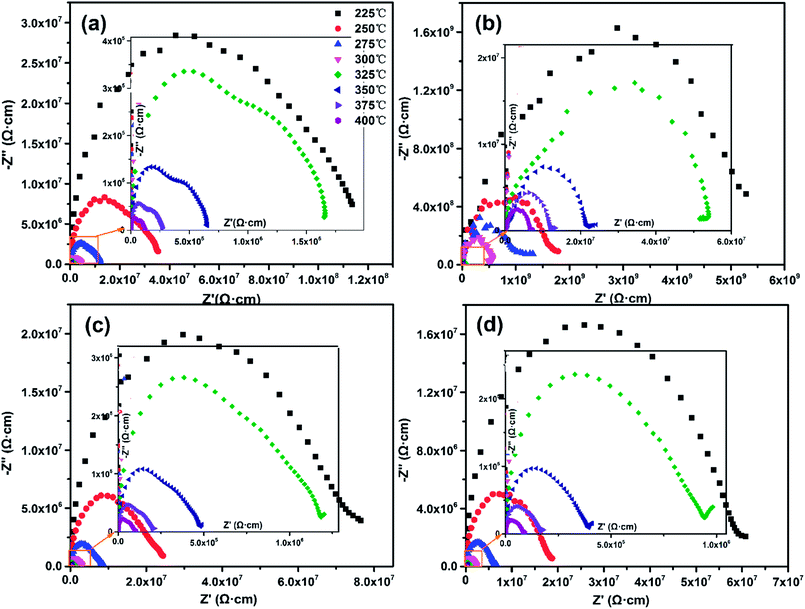 | ||
| Fig. 4 The complex impedance spectra of SBN–xBi ceramics: (a) x =−0.05; (b) x = 0.0; (c) x = 0.05; (d) x = 0.1. | ||
In order to further confirm the resistance of SBN–xBi ceramics, the variation of imaginary part of the impedance (Z') with frequency was shown in Fig. 5. One can see that only one peak appeared in the imaginary part for all samples, indicating that only one electrical component contribute to the conductivities of the ceramics, which corresponds to the undistorted Debye-like semicircles.2,29 Additionally, it is clear that the peaks were asymmetric and broadened and their positions shifted toward higher frequency side with the temperature increasing, suggesting the presence of electrical processes in the materials with a different relaxation time.30
The DC resistivity of the SBN–xBi ceramic as a function of reciprocal temperature was shown in the inset of Fig. 5. It is noted that the resistivity of all the samples are higher than 105 Ω cm even if the temperature reach up to 400 °C, indicating the SBN–xBi ceramics possessed a higher insulation resistivity, which is of necessity for piezoelectric ceramics to ensure a large electric field can be applied during poling without breakdown or excessive charge leakage and thus enhance the electrical properties.22,31 Moreover, the behavior of the temperature dependent resistivity follows Arrhenius relationship:
ρ = A![[thin space (1/6-em)]](https://www.rsc.org/images/entities/char_2009.gif) exp(−Ea/kBT) exp(−Ea/kBT)
| (1) |
Fig. 6(a) exhibits the P–E hysteresis loops of SBN–xBi ceramics measured at 10 Hz and 180 °C under an electric field of 125 kV cm−1. Detailed information on the response of the variation of remanent polarization (2Pr) for SBN–xBi ceramics as a function of x is provided in inset of Fig. 6(a). It is evident that all of the samples exhibited the typical P–E loops and the 2Pr increases at first, then decreases, while the coercive field (Ec) changes slightly with the increase of Bi2O3 content, which indicates that the Bi2O3 content plays a significant influence on ferroelectric properties. When the doping content is 0.05, the 2Pr obtained a maximum value of 17.8 μC cm−2 with a relatively low coercive field (50 kV cm−1, Table 1), suggesting the polarization state of SBN–xBi ceramics could be enhanced surprisingly within a proper range of Bi2O3 content. Proper Bi2O3 content lowered the concentration of oxygen vacancies and improve the chemical stability of the Bi2O2 layer and perovskite blocks, which is helpful to weaken the influence of domain pinning and result in the increase of the 2Pr.35 In addition, the polarization current curves of the SBN–xBi ceramics were collected so that the polarization state could be further realized, as shown in Fig. 6(b). It is clear that only one sharp polarization current peak could be observed when the applied electric field reached Ec, indicating that the ferroelectric domain could be easier to switch when the driving electric field increases to Ec.36
Fig. 7 shows the piezoelectric coefficient (d33) as a function of operating temperature for SBN–xBi piezoelectric ceramics. It is obvious that the d33 increased at first and then decreased as the Bi2O3 content increases at room temperature. The excellent piezoelectric coefficient is founded to be 18 pC N−1 when x is 0.05, which is higher than that of pure SBN ceramic as shown in Fig. 7 and Table 1. The enhanced piezoelectric activity could be attributed to the enhanced polarizability caused by the appropriate lattice distortion and the decreased amount of oxygen vacancies of the ceramics because of the regulating of Bi2O3 concentration. Moreover, increasing plate-like grains imply decreased polarization efficiency under high electric field poling condition, as related to the microstructures shown in Fig. 2(d) for the ceramics with x = 0.1, leading to the deteriorated piezoelectric properties.37 Additionally, the d33 of all samples decreases rapidly to zero or near zero as the annealing temperature is above Tc, which should be related to the increasing tan![[thin space (1/6-em)]](https://www.rsc.org/images/entities/char_2009.gif) δ as the temperature increases, as shown in Fig. 3, indicating the nature of the ferro–paraelectric phase transition.22 Corresponding to this, the d33 value of SBN–xBi ceramics remains essentially temperature-independent up to 300 °C, exhibiting the ceramics have a good thermal stability for high temperature applications.
δ as the temperature increases, as shown in Fig. 3, indicating the nature of the ferro–paraelectric phase transition.22 Corresponding to this, the d33 value of SBN–xBi ceramics remains essentially temperature-independent up to 300 °C, exhibiting the ceramics have a good thermal stability for high temperature applications.
4. Conclusions
In this article, we have successfully prepared SrBi2Nb2O9–xBi2O3 (SBN–xBi) piezoelectric ceramics using conventional solid-state progressing under the same sintering temperature of 1100 °C. The SBN–xBi ceramics presented a typical layered perovskite structure and the morphologies of Aurivillius ceramics show the grains of all the samples are well-defined and the grain size of the ceramics increases with the increase in Bi2O3 content. The piezoelectric coefficients (d33) increases up to be 18 pC N−1 and the remanent polarization (2Pr) increased up to a value of 17.8 μC cm−2 with a relatively low coercive field (50 kV cm−1) when x is 0.05. As a result, a high d33, 2Pr and good thermal stability sample has been attained in the SBN–0.05Bi ceramic. Therefore, such a material system is a potential candidate for high-temperature piezoelectric applications.Conflicts of interest
There are no conflicts to declare.Acknowledgements
This work was supported by the the Natural Science Foundation of Shandong Province of China (ZR2016EMM02), the National Key R&D Program of China (No. 2016YFB0402701), Focus on research and development plan in shandong province (No. 2017GGX202008).References
- J. Wu, W. Mao and Z. Wu, et al., Piezoelectric Er3+-doped (Ba1-xCax)(Sn0.06Ti0.94)O3 ceramic: Photoluminescence sensitive to morphotropic phase boundary, J. Alloys Compd., 2016, 684, 342–345 CrossRef CAS.
- C. Wang, Z. Xu and R. Cheng, et al., Electric field-induced giant strain and piezoelectricity enhancement effect in (Bi1/2Na1/2)0.935+xBa0.065Ti1−x(Pr1/2Nb1/2)xO3 lead-free ceramics, Ceram. Int., 2016, 42(3), 4354–4360 CrossRef CAS.
- H. Tao and J. Wu, Giant piezoelectric effect and high strain response in (1−x)(K0.45Na0.55)(Nb1−ySby)O3-xBi0.5Na0.5Zr1−zHfzO3 lead-free ceramics, J. Eur. Ceram. Soc., 2016, 36(7), 1605–1612 CrossRef CAS.
- T. Wei, C. Z. Zhao and Q. J. Zhou, et al., Bright green upconversion emission and enhanced ferroelectric polarization in Sr1−1.5xErxBi2Nb2O9, Opt. Mater., 2014, 36(7), 1209–1212 CrossRef CAS.
- T. Wei, C. P. Li and Q. J. Zhou, et al., Upconversion luminescence and ferroelectric properties of Er3+ doped Bi4Ti3O12-SrBi4Ti4O15, Mater. Lett., 2014, 118, 92–95 CrossRef CAS.
- S. Khasa, P. Singh and S. Sanghi, et al., Structural analysis and dielectric characterization of Aurivillius type CaSrBi2Nb2O9 ceramics, J. Integr. Sci. Technol., 2014, 2(1), 13–21 Search PubMed.
- R. Hou, X. Chen and Y. Zeng, Diffuse Ferroelectric Phase Transition and Relaxor Behaviors in Ba-Based Bismuth Layer-Structured Compounds and La-Substituted SrBi4Ti4O15, J. Am. Ceram. Soc., 2006, 89(9), 2839–2844 CAS.
- J. S. Kim, M. S. Jang and I. W. Kim, et al., Niobium doping effects and ferroelectric relaxor behavior of bismuth lanthanum titanate, J. Electroceram., 2006, 17(2–4), 129–133 CrossRef CAS.
- Z. Yao, R. Chu and Z. Xu, et al., Processing and enhanced electrical properties of Sr1-x(K0.5Bi0.5)xBi2Nb2O9 lead-free piezoelectric ceramics, Ceram. Int., 2016, 42(9), 10619–10623 CrossRef CAS.
- Z. Yao, H. Li and M. Ma, et al., Preparation and electrical properties of (1−x)SrBi2Nb2O9−xBiFeO3 lead-free piezoelectric ceramics, Ceram. Int., 2016, 42(4), 5391–5396 CrossRef CAS.
- T. Wei, Z. Dong and C. Z. Zhao, et al., Up-conversion luminescence and temperature sensing properties in Er-doped ferroelectric Sr2Bi4Ti5O18, Ceram. Int., 2016, 42(4), 5537–5545 CrossRef CAS.
- Y. L. Du, G. Chen and M. S. Zhang, Grain size effects in Bi4Ti3O12 nanocrystals investigated by Raman spectroscopy, Solid State Commun., 2004, 132(3–4), 175–179 CAS.
- Z. Zhen, H. Yan and P. Xiang, et al., Grain Orientation Effects on the Properties of a Bismuth Layer-Structured Ferroelectric (BLSF) Bi3NbTiO9 Solid Solution, J. Am. Ceram. Soc., 2004, 87(4), 602–605 CrossRef.
- X. X. Wang, X. G. Tang and K. W. Kwok, et al., Effect of excess Bi2O3 on the electrical properties and microstructure of (Bi1/2Na1/2)TiO3 ceramics, Appl. Phys. A: Mater. Sci. Process., 2005, 80(5), 1071–1075 CrossRef CAS.
- Q. Guo, H. Sun and X. Liu, et al., Effect of excess Bi content on electrical properties of BiFe0.95Cr0.05O3 thin films, J. Mater. Sci.: Mater. Electron., 2017, 28(23), 17399–17404 CrossRef CAS.
- H. Du, D. Liu and F. Tang, et al., Microstructure, Piezoelectric, and Ferroelectric Properties of Bi2O3-Added (K0.5Na0.5)NbO3 Lead-Free Ceramics, J. Am. Ceram. Soc., 2007, 90(9), 2824–2829 CrossRef CAS.
- Y.-R. Zhang, J.-F. Li and B.-P. Zhang, et al., Piezoelectric and ferroelectric properties of Bi-compensated (Bi1/2Na1/2)TiO3–(Bi1/2K1/2)TiO3 lead-free piezoelectric ceramics, J. Appl. Phys., 2008, 103(7), 074109 CrossRef.
- C. Qin, Z.-Y. Shen and W.-Q. Luo, et al., Effect of excess Bi on the structure and electrical properties of CaBi2Nb2O9 ultrahigh temperature piezoceramics, J. Mater. Sci.: Mater. Electron., 2018 DOI:10.1007/s10854-018-8778-9.
- A. Khokhar, P. K. Goyal and O. P. Thakur, et al., Effect of excess of bismuth doping on dielectric and ferroelectric properties of BaBi4Ti4O15 ceramics, Ceram. Int., 2015, 41(3), 4189–4198 CrossRef CAS.
- S. K. Rout, A. Hussain and E. Sinha, et al., Electrical anisotropy in the hot-forged CaBi 4 Ti 4 O 15 ceramics, Solid State Sci., 2009, 11(6), 1144–1149 CrossRef CAS.
- H. Chen, S. Bo and J. Xu, et al., Correlation Between Grain Sizes and Electrical Properties of CaBi2Nb2O9 Piezoelectric Ceramics, J. Am. Ceram. Soc., 2012, 95(11), 3514–3518 CrossRef CAS.
- Z. Yao, R. Chu and Z. Xu, et al., Thermal stability and enhanced electrical properties of Er3+-modified Na0.5Bi4.5Ti4O15lead-free piezoelectric ceramics, RSC Adv., 2016, 6(97), 94870–94875 RSC.
- J. Hao, Z. Xu and R. Chu, et al., Bright reddish-orange emission and good piezoelectric properties of Sm2O3-modified (K0.5Na0.5)NbO3-based lead-free piezoelectric ceramics, J. Appl. Phys., 2015, 117(19), 194104 CrossRef.
- D. C. Sinclair and A. R. West, Impedance and modulus spectroscopy of semiconducting BaTiO3 showing positive temperature coefficient of resistance, J. Appl. Phys., 1989, 66(8), 3850–3856 CrossRef CAS.
- T. Li, H. Fan and C. Long, et al., Defect dipoles and electrical properties of magnesium B-site substituted sodium potassium niobates, J. Alloys Compd., 2014, 609, 60–67 CrossRef CAS.
- T. Badapanda, R. K. Harichandan and S. S. Nayak, et al., Frequency and temperature dependence behaviour of impedance, modulus and conductivity of BaBi4Ti4O15 Aurivillius ceramic, Process. Appl. Ceram., 2014, 8(3), 145–153 CrossRef.
- S. K. Rout, S. Parida and E. Sinha, et al., Frequency-temperature response of CaBi4Ti4O15 ceramic prepared by soft chemical route: Impedance and modulus spectroscopy characterization, Curr. Appl. Phys., 2010, 10(3), 917–922 CrossRef.
- H. Zhang, H. Deng and C. Chen, et al., Chemical nature of giant strain in Mn-doped 0.94(Na0.5Bi0.5)TiO3-0.06BaTiO3 lead-free ferroelectric single crystals, Scr. Mater., 2013, 75(4), 50–53 Search PubMed.
- J. Hao, Z. Xu and R. Chu, et al., Bright reddish-orange emission and good piezoelectric properties of Sm2O3-modified (K0.5Na0.5)NbO3-based lead-free piezoelectric ceramics, J. Appl. Phys., 2015, 117(19), 194104 CrossRef.
- M. Boukriba, F. Sediri and N. Gharbi, Hydrothermal synthesis and electrical properties of NaNbO3, Mater. Res. Bull., 2013, 48(2), 574–580 CrossRef CAS.
- Q. Wang, C.-M. Wang and J.-F. Wang, et al., High performance Aurivillius-type bismuth titanate niobate (Bi3TiNbO9) piezoelectric ceramics for high temperature applications, Ceram. Int., 2016, 42(6), 6993–7000 CrossRef CAS.
- A. Peláiz-Barranco and Y. González-Abreu, Oxygen vacancies related electrical response in modified lead titanate ceramics, Solid State Commun., 2009, 149(45–46), 2082–2084 CrossRef.
- A. Palanduz and D. Smyth, Defect chemistry and charge transport in SrBi2Nb2O9, J. Electroceram., 2003, 11(3), 191–206 CrossRef CAS.
- S. Bharadwaja and S. Krupanidhi, Growth and study of antiferroelectric lead zirconate thin films by pulsed laser ablation, J. Appl. Phys., 1999, 86(10), 5862–5869 CrossRef CAS.
- F. Qiang, J.-H. He and J. Zhu, et al., Ferroelectric and dielectric properties of bismuth-layered structural Sr2Bi4−xLnxTi5O18 (Ln=La, Nd, Sm and Dy) ceramics, J. Solid State Chem., 2006, 179(6), 1768–1774 CrossRef.
- Z. Yao, R. Chu and Z. Xu, et al., Structure and electrical properties of lead-free Sr1−x(K,Ce)x/2(Na0.5Bi0.5)Bi4Ti5O18 piezoelectric ceramics, RSC Adv., 2016, 6(17), 13803–13808 RSC.
- Z. Y. Shen, W. Q. Luo and Y. Tang, et al., Microstructure and electrical properties of Nb and Mn co-doped CaBi4Ti4O15 high temperature piezoceramics obtained by two-step sintering, Ceram. Int., 2016, 42(6), 7868–7872 CrossRef CAS.
| This journal is © The Royal Society of Chemistry 2018 |

